
History of the Gaelscoil Movement
This page provides useful contextual information for users who wish to use the interactive ArcGIS map which can be found HERE. The functionality of the map is better on computers than on small handheld devices.
There are 53 oral interviews housed in the interactive map which can be accessed by clicking on the slightly larger coloured points representing schools and then on “Eolas” (Information). There are some schools which have two interviews. In those cases, the second interview can be located in the description underneath the video.
All the interviews to do with the organisation Gaelscoileanna/Gaeloideachas can be found by clicking on the point where the current office is located in Marino, Dublin.
Or, alternatively, all the interviews can be found on YouTube HERE or on Zenodo HERE
The Growth of Irish-medium Schools
Every gaelscoil, Gaeltacht school, gaelcholáiste, secondary Gaeltacht school and second-level units are shown in the above map, and below they are shown by type.

Legend
Geographic Growth
Using a timeline, geographic growth is displayed in these maps. In the first map (1921 on the timeline) the Gaeltacht schools are visible, but outside of that there existed only one or two gaelscoileanna in the country, which had been founded during the years of the language revival.
After that (1979 on the timeline) we can see the growth that has occurred in Dublin especially from the end of the sixties onwards and into the seventies, a development which occurred in the context of urbanisation and the growth of new suburbs on the city’s peripheries.
By 1989, substantial growth had occurred in Cork and there were a number of schools in the Six Counties. Progress was made in Connacht, Munster and East Leinster during the 1980s too.
Growth of gaelscoileanna increased in the Six Counties in the 1990s as conflict began to come to an end.
As can be seen in the fourth and fifth map Irish-medium education spread to every county in the country from the 1990s onwards.
Growth over time
The number of gaelscoileanna and gaelcholáistí (including units), as well as the number of students attending them, has increased steadily over time as the bar charts below demonstrate.
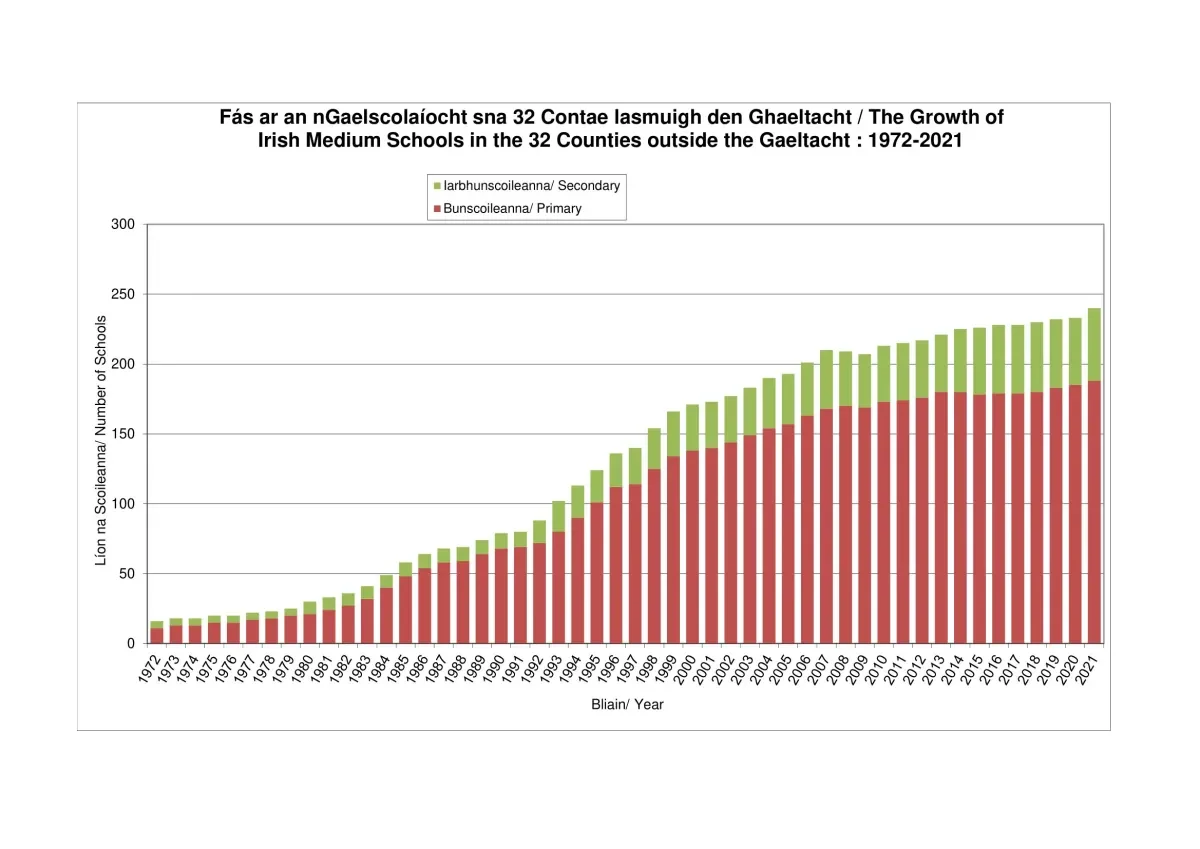
Growth outside the Gaeltacht
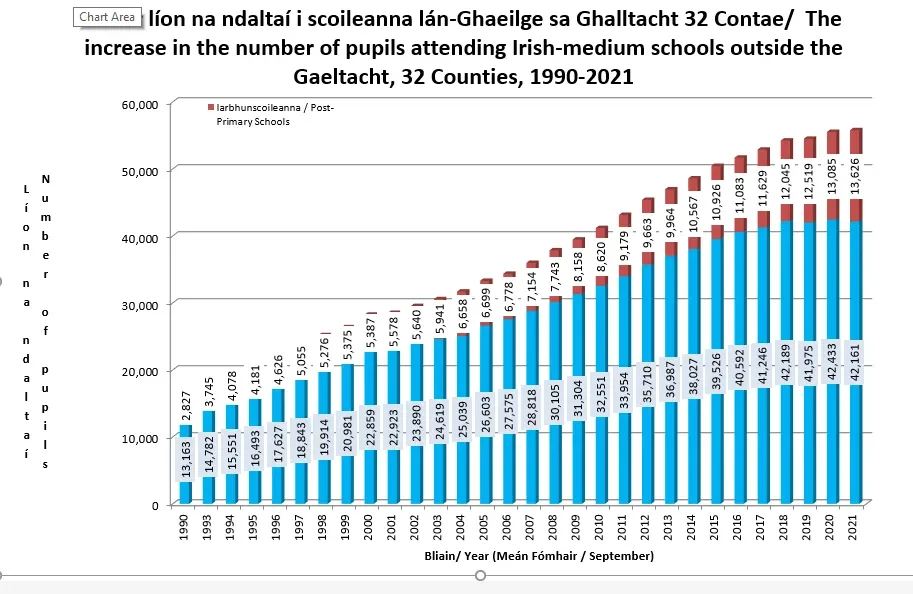
Growth in the Number of Pupils
When it comes to the number of Irish-medium schools founded per year, there were peaks in the mid-1990s and again in the mid-2000s. But there has been a drop-off since the Department of Education in the Twenty-Six Counties altered the rules around founding schools and austerity policies impacted the sector.
The main peak of Irish-medium schools being established when we look at the ten-year intervals was the mid-1990s, and there has been a decline since then.
Socioeconomics
The following is information that was generated through cross-referring the map of gaelscoil growth geographically with a layered map provided by POBAL on deprivation and the Northern Ireland Multiple Deprivation Measure
POBAL ranks areas by most to least affluent, from 1 to 7, or from blue to yellow to red:
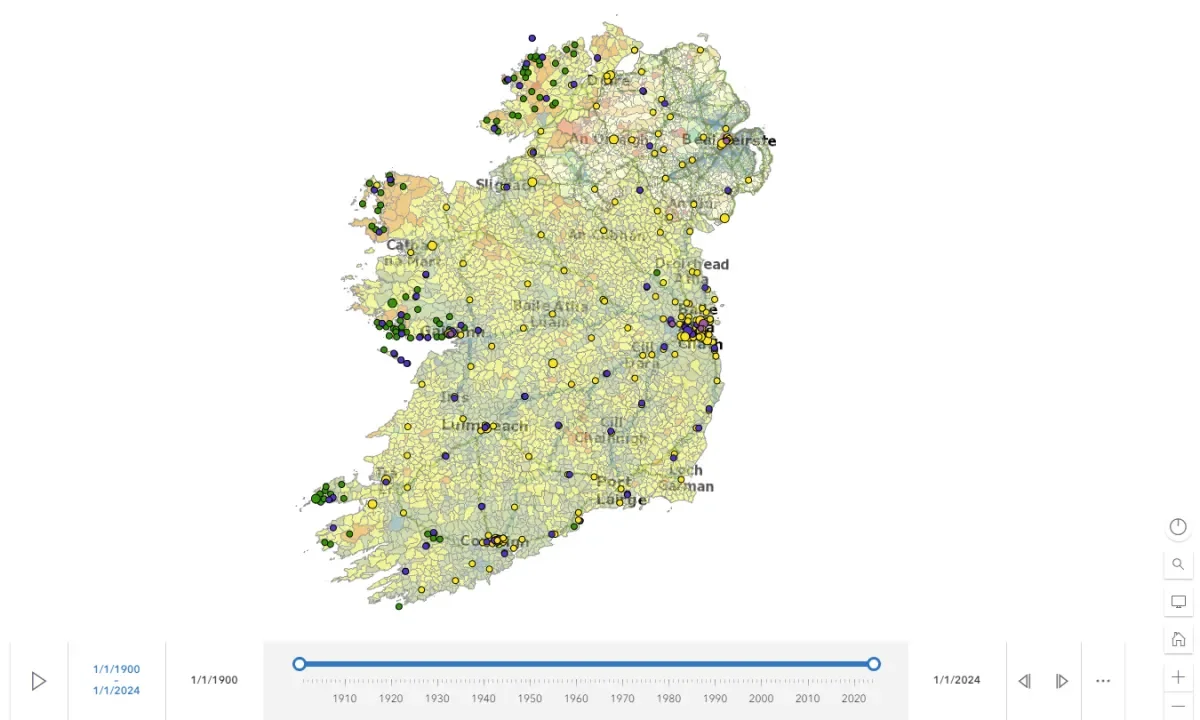
Socioeconomics
- Very affluent
- Affluent
- Slightly above average
- Slightly below average
- Disadvantaged
- Very disadvantaged
- Extremely disadvantaged
There is a slightly more complicated ranking system for the Six Counties which uses a different numbering system, which runs from 1 (the most deprived area) to 5022 (the most affluent area). The areas in the North can therefore be integrated into the Twenty-Six County ranking system by dividing 5022 into 7 sections.
Using this system for the 32 Counties in total (including the Gaeltacht and areas outside it), we can see from the bar chart below that: 26 schools are located in areas that are wealthy; 103 schools are located in areas that are slightly above average; the most schools, 157, are located in areas which are slightly below average; while 64 schools are in areas that are deprived, 8 are in areas that are very deprived, with 14 in areas that are extremely deprived.
Of course, there is an important qualification to be made as this evidence only shows the areas in which Irish-medium schools are situated. It does not show the class composition of the student body within each school. For example, Gaelscoil Inse Chóir is located in an affluent area, Islandbridge, but its catchment area serves deprived areas such as Ballyfermot.
That said, the bar-chart and wave-chart are reliable enough measurements which demonstrate that the median line (seen in purple) is 4, which is slightly below the average.
There are more schools in the country (241 in total) located in areas which are below the average, than there are in areas which are above it, 139.
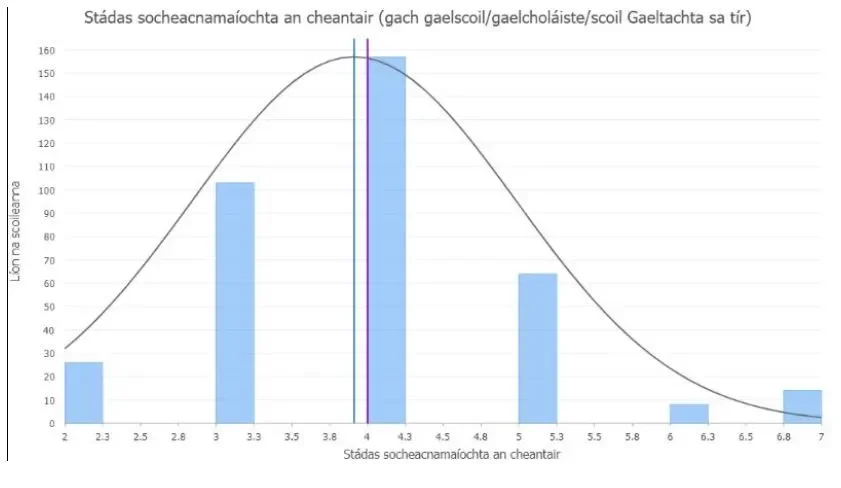
Socioeconomic status
We must, however, take geographic differences in each jurisdiction into account too. There are more schools situated in deprived areas in the Six Counties than there are in the Twenty-Six Counties, both in the Gaeltacht and outside it.

Socioeconomic status of Belfast

Socioeconomic status of Cork City

Socioeconomic status of Dublin
Number of Irish speakers
A certain amount can be gleaned from the map showing Irish-medium school growth when it is cross-referenced with the Census of 2016 that shows the number of Irish speakers in each electoral division in the Twenty-Six Counties.
All told, there is a foundation of Irish speakers where gaelscoileanna or gaelcholáistí exist, but this is only an opinion rather than a more scientific analysis as above, and simple demographics must be taken into account as well.
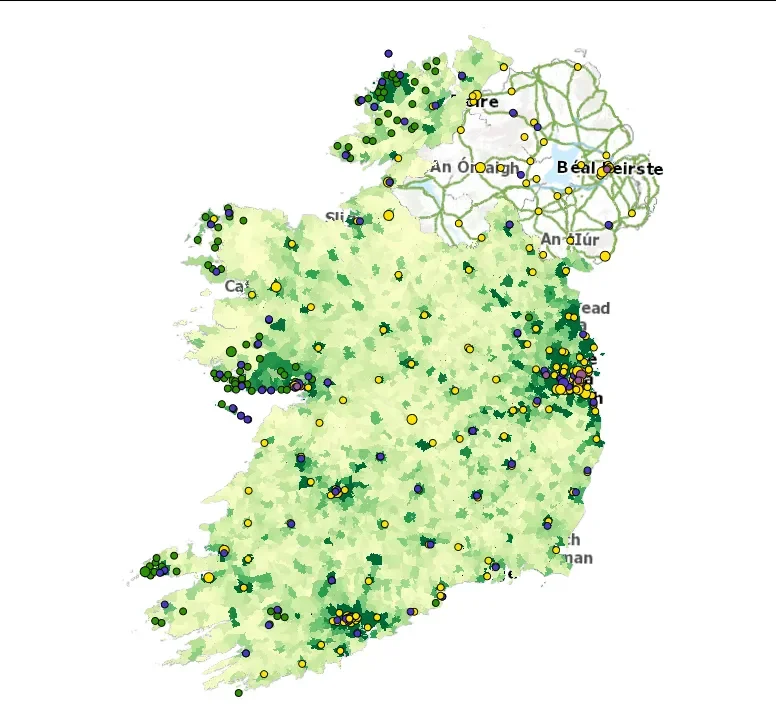
Irish Speakers
If a map showing the daily speakers of Irish outside the education could be integrated into the map showing growth of the sector a more fruitful cross-referring might be possible.
But if we look at a couple of towns with similar sized populations (one which has a gaelscoil and one which doesn’t), it appears that the number of daily Irish speakers outside the education is the same regardless of the presence of Irish-medium education. There are exceptions to this pattern, however.
Irish-medium schools are often not succeeding in taking the language “beyond the gates of the schools” – a view which was expressed frequently in the interviews conducted.
Another contention that can be made from the map showing the number of speakers when cross-referenced with the growth of the school network, is that there exists a cluster of towns, outside of the cities, that “should” have a gaelscoil located within them. These towns have the population density, a pre-existing basis of Irish speakers, as well as positivity towards the language, yet do not have a gaelscoil.
For example, in East Connacht, there is a gaelscoil in Manhorhamilton as shown in the map below.
The electoral division of Manorhamilton has 1,892 people residing within it, 707 of whom claim to be able to speak Irish to some degree. However, in Swinford, which has a population of 2,527 and 1,016 Irish speakers and Castlereagh which has 2,971 and 958 Irish speakers, there is no Irish-medium provision. There are a good deal of towns that fit this pattern.
Another example is Kilorglin and Kenmare which can be seen in the map below.
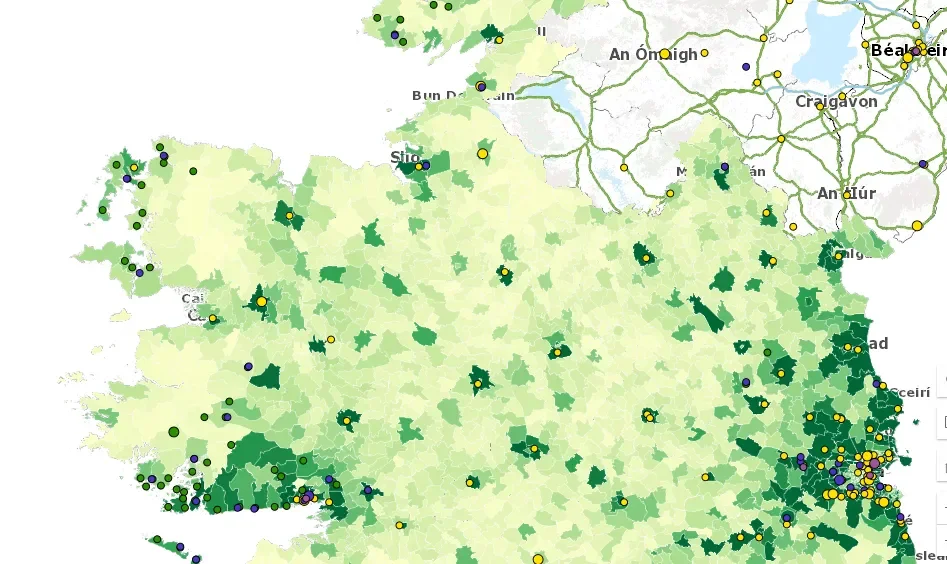
East Connaught
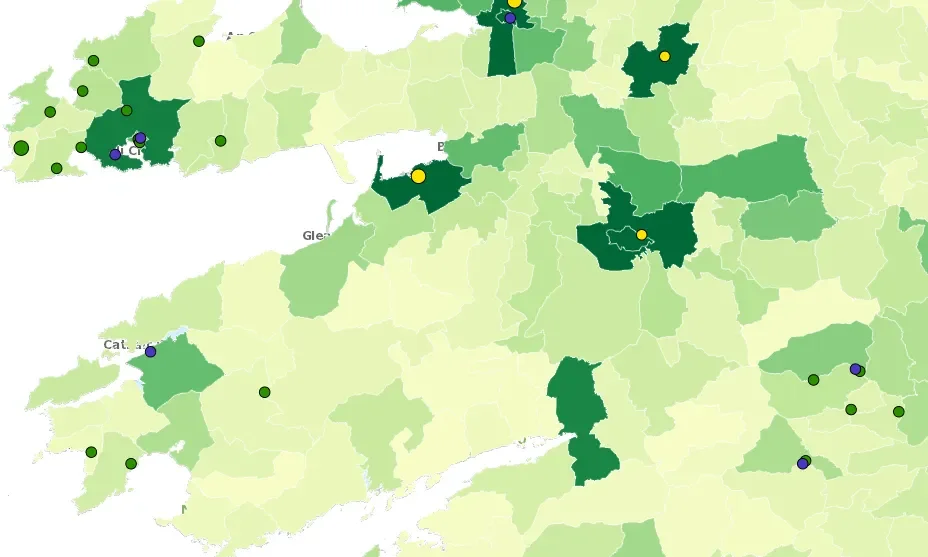
South Kerry
Conclusions
Overall, the maps and evidence above demonstrate a monumental achievement by the gaelscoil movement over the last 50 years in growing the network of Irish-medium schools. Challenges remain, however. In the Twenty-Six Counties, in particular, the growth of the sector has slowed due to decisions taken by the Department of Education and there are still gaps in provision, especially in geographic areas and socio-economically deprived locations.


















